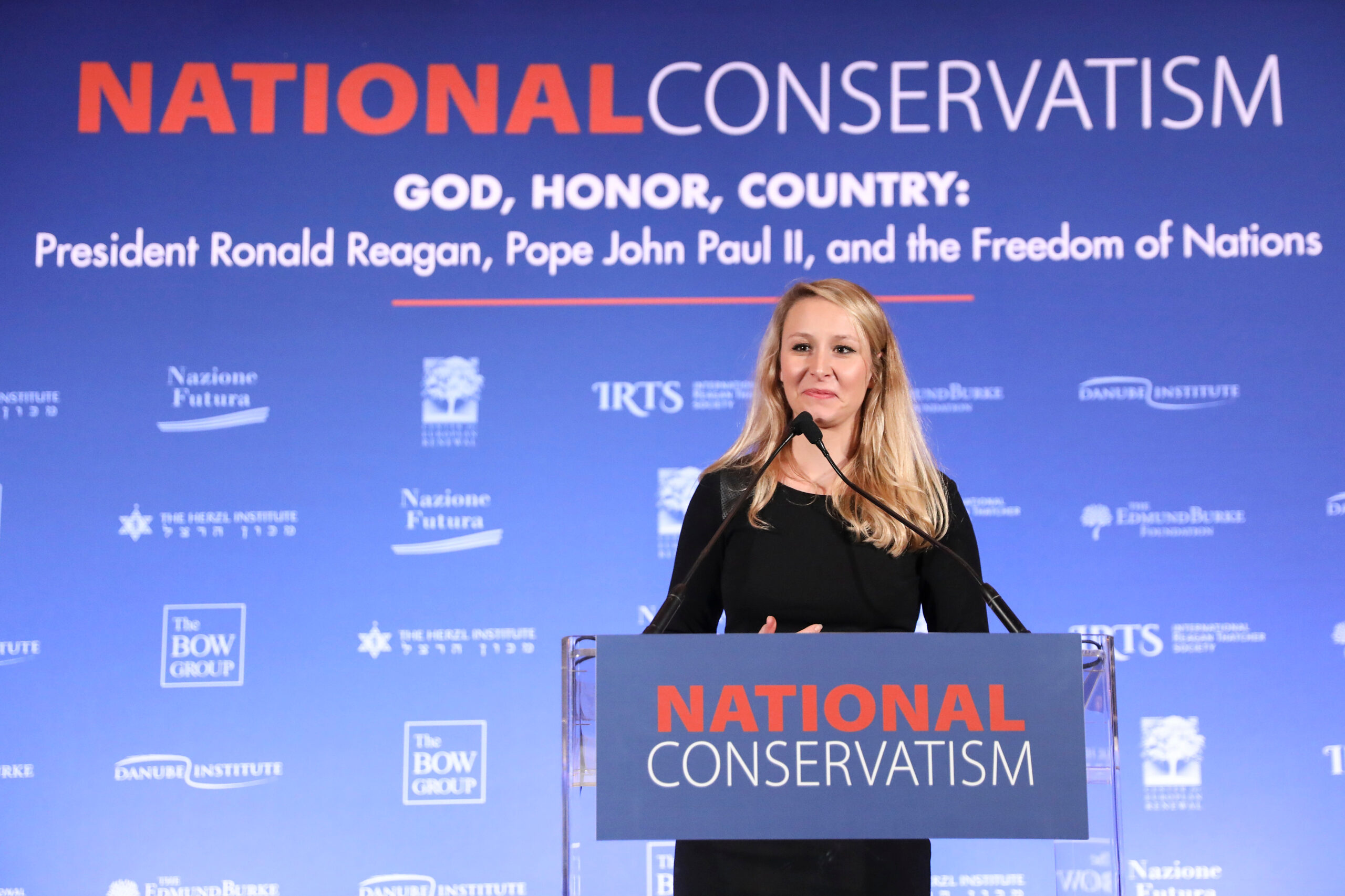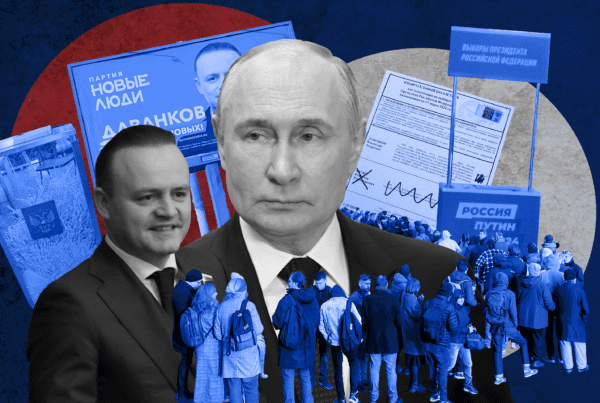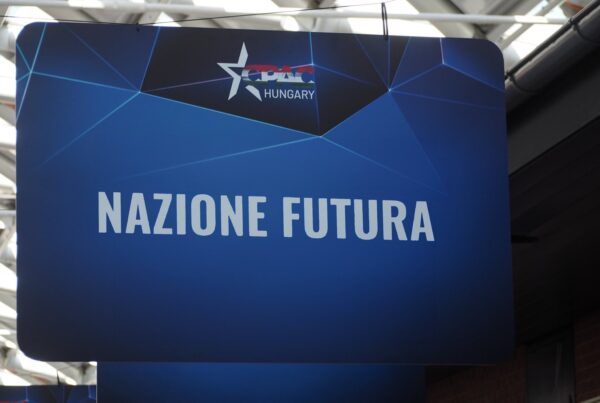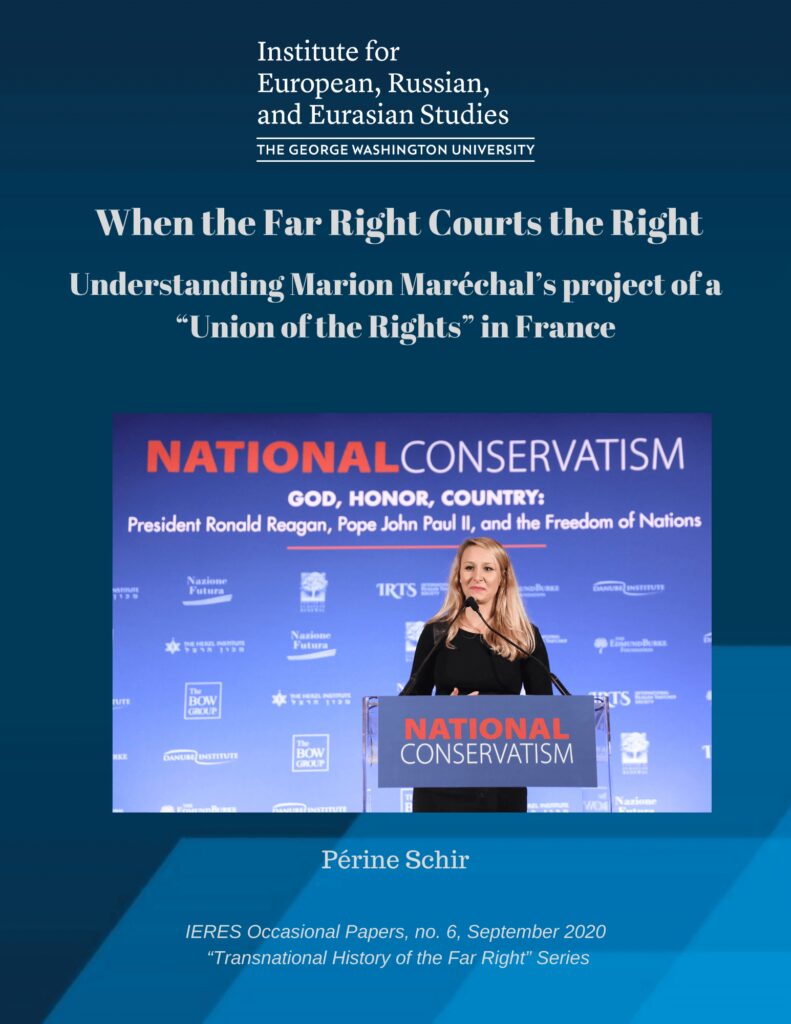
When the Far Right Courts the Right: Understanding Marion Maréchal’s project of a “Union of the Rights” in France
Périne Schir
IERES Occasional Papers no. 7, September 2020
Transnational History of the Far Right Series
Cover photo: Rome, Italy, February 4, 2020. Marion Maréchal, lawmaker of the National Rally, speaks during the National Conservatism conference in Rome, Italy, on Tuesday, Feb. 4, 2020. @Alessia Pierdomenico, Shutterstock.
@IERES2020
A growing number of scholars and politicians have been declaring that left and right no longer make sense in France and that we are currently witnessing a restructuring of the political landscape as we have always known it. Admittedly, the old parties are in shambles: the right-wing Les Républicains (LR) are licking the wounds of their monumental failure at the European elections of 2019, while at the left-wing Parti Socialiste, pale candidates are fighting over what’s left of their party since its historically low score in the presidential elections of 2017.
This rhetoric on the collapse of the right/left divide was largely echoed by Emmanuel Macron during his 2017 presidential campaign, presenting himself as “neither right-wing nor left-wing.” This posture was meant to be critical of these two classic antithetical references in the name of an ambiguous—and therefore limitless—“ailleurs” (elsewhere) or middle way. This was certainly an important element of his success: this way, Emmanuel Macron could fit the expectations of the disappointed moderate voters on both the left and the right, who were ready to experiment with a more centrist strategy.
But it was during the European election campaign of 2019 that this discourse was taken a step further. Emmanuel Macron attempted to define his “elsewhere” by framing it as a modern “progressivism” opposed to a backward “populism.” The idea at the time was to unite pro-Europeans against the front-runners of the election: the far-right forces united behind Marine Le Pen in France and Matteo Salvini in Italy. This new binary led to a dramatic consequence: it presented the far right as the only conceivable alternative to Emmanuel Macron’s economic model, the positive consequences of which are increasingly difficult for the average voter to perceive.
This political transformation of the French political landscape has also been seen by self-appointed apostles on the far right as an opportunity to cook up a new political force, nicknamed the “Union of the Rights” project by the media. It aims at capturing as much as possible of what remains of the classical,mainstream right and at implementing the key discursive points that differentiate “right” from “left”regarding national identity, immigration, and security.
This Union of the Rights project, led by the youngest of the Le Pen family, 30-year-old Marion Maréchal, belongs to the new wave of “national conservatism”: a political brand (in lieu of being a solid ideology) created to promote a sort of “Trumpism without Trump,” that is, trying to build “a kernel of coherent ideology that can outlast the Trump presidency” and be implemented in different national contexts. The polarization of the French political landscape between Emmanuel Macron’s liberal centrism on one side and Marine Le Pen’s Rassemblement National on the other has offered fertile soil for a more offensive strategy, that of Le Pen’s niece Marion, to absorb what remains from the classic, mainstream right in France.
Marion Maréchal’s Plans for France
Step one of the analysis consists of identifying the cooks: a team led by Marion Maréchal, the niece of leader of the Rassemblement National or RN—formerly known as the Front National—Marine Le Pen.
Marion Maréchal announced her so-called “withdrawal from political life” and her consequent resignation from the RN in 2017 at age 27. But in reality, the only bridges that were burned at that time were with her former party, her aunt Marine Le Pen’s RN. Indeed, since her retirement, Marion Maréchal and Marine Le Pen have been engaged in a remote arm wrestling match, without really acknowledging it.
Since 2017, Marion Maréchal has always refused to endorse or give any type of public support to the RN.Even during the campaign for the European elections, she refused to take a stand for her former political family, going so far as to refuse the slightest tweet of support for the list led by RN’s no. 2, Jordan Bardella.
But Marion Maréchal’s attitude actually makes sense when one knows about the big picture. Her refusal is consistent with a strategy of distancing herself from the RN—not because she wants to move her career away from politics, but instead because she has a plan to give the far right a prominent place in the upcoming political chess game, and this plan does not involve her aunt.
Marion Maréchal and Marine Le Pen have two different approaches for making the far right into a legitimate electoral option. Marine Le Pen’s goal is to “de-demonize” the Rassemblement National, i.e., to rid the party from any external signs of xenophobia and symbols associated with the old-fashioned far right (antisemitism, denialism, reactionary Catholicism, etc.). On the contrary, Marion Maréchal clearly assumes and claims the symbols that have traditionally marked the French far-right identity, even the most controversial ones.
This line of action is embodied by Marion Maréchal’s Institute of Social, Economic and Political Sciences (ISSEP), the far-right “metapolitical school” that she founded in Lyon in 2018. One of her first measures was to choose a symbolic patron saint for the first ever 2018 class of ISSEP: General George Loustaunau-Lacanau (1894–1955), a collaborator of Marshal Pétain, also known for having compared the Jews to a“cancer.”
The “scientific board” of ISSEP reflects the institution’s anchorage in the far right: among the notable members are former editor-in-chief of Breitbart News London and adviser to Nigel Farage, Raheem Kassam, and Pascal Gauchon, former secretary general of the “Parti des Forces Nouvelles” (PFN), a neofascist splinter party of Front National in the 1980s. Among the classes offered, one can find “legit”options acting as smokescreen—like management and business strategy courses—but also more problematic ones, like a “History of Religions and Civilizations”— taught with a very anti-secular mindset—or commando training.
This can-do attitude enabled Marion Maréchal to win over the heart of her grandfather, Front National co-founder and far-right superstar Jean-Marie Le Pen. In the second volume of his memoirs, Jean-Marie Le Pen confirmed this unwavering support toward Marion Maréchal, describing her as “an exceptionally brilliant woman” with “a talent above the competition”—while at the same time reproaching Marine for “a desperate search for de-demonization at a time when the devil is becoming popular.”
But if Marion Maréchal refuses to disguise the far right as a “moderate” option, as her aunt does, it does not mean that she refrains from wooing right-wing conservative voters in order to enlarge her electoral base. Indeed, according to her, the far right “could never come to power in its present form”—i.e., with the current RN led by her aunt. On the contrary, Marion Maréchal wants to “anchor [the right and the far right] in a common future” by proposing a “grand coalition” between the liberal-conservatives—represented in France by the Les Républicains (LR) party[1]—and the far right.
This initiative was received with interest by LR’s rightmost fringe elements during a dinner with Marion Maréchal in June 2019. If this plan is not universally popular within the party, the timing of this offer could not be more favorable to those who broke bread with Marion Maréchal. Since LR’s resounding failure in the European elections of May 2019, the party has been described as a sinking ship in need of anew driving force—a new impulse that could be embodied in Marion Maréchal’s project of a “Union of Rights.”
Although we do not yet know what form this project is going to take, or whether Marion Maréchal will be its official face, she definitely has been busy moving the pieces on the chess board to prepare for her big move. In the chart below, I have graphically represented the network of organizations on which Marion Maréchal is building her project.
Graph 1. The network of organizations on which Marion Maréchal is building her project “Union of the Rights”
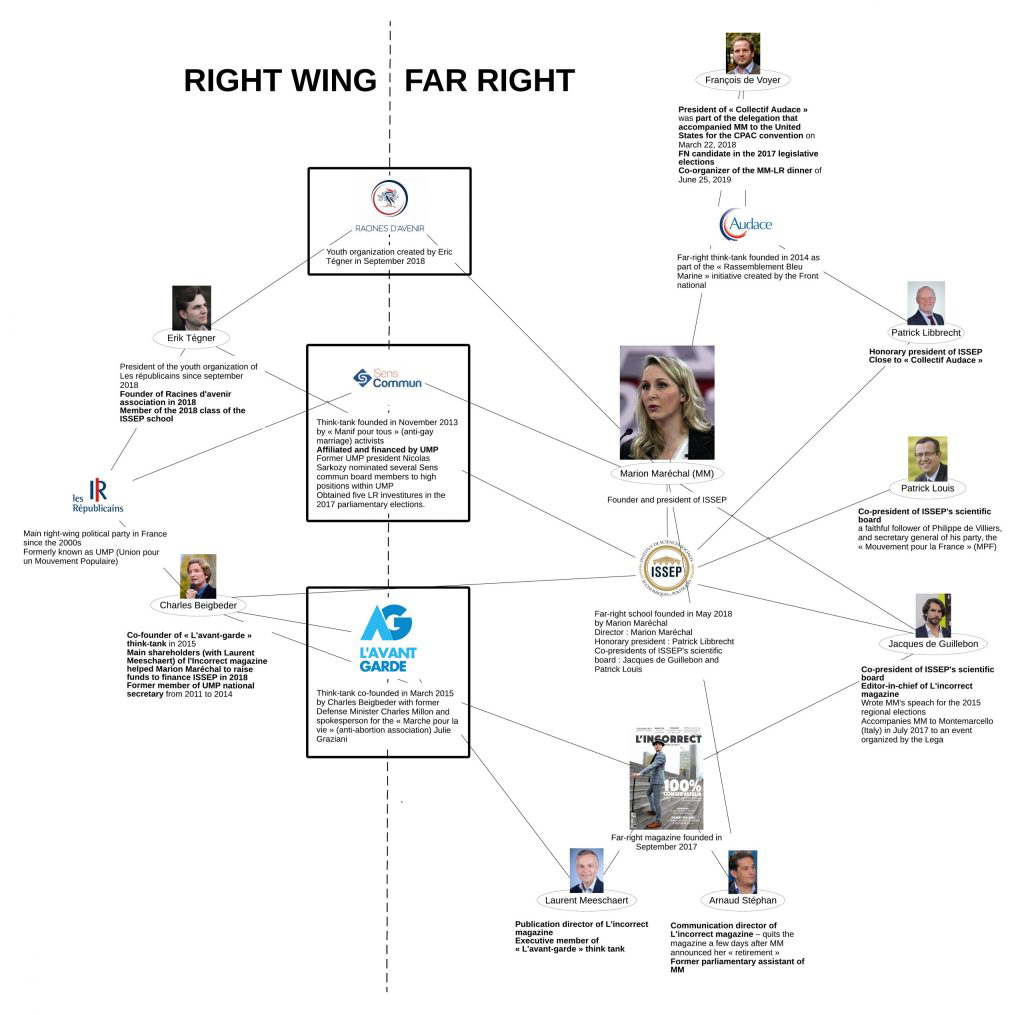
One characteristic of the chart above must be highlighted. Three of the key organizations linked to the Union of the Rights projects, L’Avant Garde, Sens Commun, and Racines d’avenir, are situated ambiguously on the political spectrum between the right and the far right. The vagueness of their political positioning is achieved strategically by mixing various ideological and institutional positions while developing a far-right-inclined rhetoric.
One example of this strategic positioning is Sens Commun. In 2013, France became the fourteenth country in the world to legalize same-sex marriage. This vote ended a year of demonstrations by opponents of the law organized by various associations, including a collective called “La Manif pour tous” (Protest for All).Noting the failure of their mobilization in the streets, some members of the collective decided to found apolitical movement called Sens Commun within the Républicains. Their goal now is to steer the wheel of the LR party in favor of conservative values, that is, further to the right. The same story can be told for the anti-abortion think tank L’Avant Garde, whose trajectory went from street protests to backstage string-pulling.
While Marion Maréchal works with those two organizations in broadening her political base, a third avenue has been opened by Eric Tegnér, heir of several prominent far-right families. Originally a Front National member, but disappointed by Marine Le Pen’s de-radicalization strategy, Tegnér joined LR to look for a new electoral base in the right wing of Sarkozy’s followers. But his maneuvers with Marion Maréchal were noticed by the leadership of LR, and he was kicked out at the end of 2019 for realigning with the far right. Tegnér has since founded the cradle-robbing “Racine d’avenir” as a separate youth movement set up outside of LR. It aims at recruiting LR youth and encouraging them to hang out with their far-right counterparts, as RN youth are also welcomed in the organization.
Marion Maréchal is also increasingly becoming a reference point for new alliances within different factions of the international right. Her outreach to high-level networks of the extreme right started at a private meeting in Vienna on May 31, 2014, hosted by Russian oligarch Konstantin Malofeev. On February 22, 2018, she spoke at the mainstream Republican conservative rally of the U.S. right wing, the Conservative Political Action Conference (CPAC) held near Washington, D.C. CPAC was founded in 1973 by the right wing of the Republican Party to mobilize its forces to take over the party. After Marion Maréchal’s CPAC presentation, Steve Bannon—now active in mobilizing the European right—gushed that “she is not simply a rising star on the right in France. She’s one of the most impressive people in the entire world.”
Among her more recent networking crusades was her attendance at the “National Conservatism” meeting that took place in Rome on February 4, 2020. Organized by Israeli nationalist[2] Yoram Hazony, the event aimed at discussing the “rise of nationalism” in Europe as a “continuation of the best political traditions of the last century.” Marion Maréchal’s attendance at this conference is indicative of her willingness to seek collaboration with international networks, but even more importantly, it shows their willingness to listen to her as a leading figure representing the French far right. The meeting represented the anti-Muslim interface between the Israli and European right wings.
The Rome conference was opened by Giorgia Meloni of the Italian Fratelli d’Italia party—the main heir of the neo-fascist Movimento Sociale Italiano (MSI) formed in 1946 by supporters of Benito Mussolini—and was also addressed by nationalist Hungarian prime minister Viktor Orbán. It is also worth mentioning that Marion Maréchal traveled to Italy with three of the figures I identified as junction points of her nebula: François de Voyer (Cercle Audace), Jacques de Guillebon (of L’incorrect magazine and co-president of ISSEP’s scientific board), and Erik Tegnér.
A Tale of Supply and Demand
After identifying the cooks, step two of the analysis focuses on the recipe itself: the narrative behind the Union of the Rights project, the story that explains why putting the whole right-wing spectrum in the same basket, from conservatives to fascists, is perceived as an opportunity to fill an identified social demand. The opportunity we are talking about here is a redistribution of the forces on the French political chessboard, the ever-growing market-friendly “liberal center” pushing the traditional left and right off the board.
The first step has been to emphasize these favorable circumstances and the niche to be exploited to the right investors. This is the goal of Marion Maréchal and her colleagues—what I call the “networking bureau,” a spokesman for the Union of the Rights community, translating the collective thinking of its members into action. The ultimate goal of the bureau is to organize networking events to meet potential collaborators and facilitate the meeting of individuals who would not have the opportunity to mingle if it were not for this dedicated environment. This was for instance the goal of the dinner between Marion Maréchal and members of the LR organized by Jacques de Guillebon and Erik Tegnér on June 25, 2019. Another example of these networking events is the “right-wing convention” organized by the same Erik Tegnér and another member of the bureau, François de Voyer, on September 28, 2019.
To supply the demand side, the term l’Union des droites (Union of the Rights) was coined to represent the new face of the political opposition to Emmanuel Macron. But the idea in itself is nothing new: it was invented more than a decade ago by Patrick Buisson, the main adviser of Nicolas Sarkozy for his 2007 and 2012 presidential campaigns. Buisson was the perfect candidate for this job of stitching together right and far right, as he, too, was navigating in this midwater. After his upbringing in a royalist family, he had already made a name for himself in far-right circles, notably by his managing positions in two major far-right newspapers: Minute, very close to the National Front, where he was on staff since 1981 and was director in 1986–1987; and Valeurs Actuelles, which he joined in 1987 and was appointed managing editor from 1992–1998. Originally created as a stock market newsletter in 1966, Valeurs Actuelles’ liberal-conservative editorial line was radicalized in 2012 with the arrival of Yves de Kerdrel at its head, to be replaced a few years later by Geoffroy Lejeune, reportedly very close to Marion Maréchal. This is why it was to Valeurs Actuelles that Marion Maréchal gave her interview-testament when “retiring”in May 2017 and it is still to the same magazine that she made her media comeback in February 2018.
The Union of the Rights project Buisson proposed to Sarkozy was of a slightly different kind, although it followed the same logic of reaching out to the voters of the then-Front National. The unspoken pact to the voters was as follows: since Jean-Marie Le Pen has no chance of actually being elected, the Front National electorate should vote for Nicolas Sarkozy, who will put more or less the same ideas into practice. Hence the themes that could be found in his campaign speeches, playing on the equation between insecurity and immigration, insisting on his refusal of communitarianism (communautarism, a politically correct way to criticize the supposed Islamization of France) and on the opposition between so-called hard-working people who rise early and the lazy who indulge in unemployment.[3]
To capture the far-right electorate, Buisson created a compelling populist narrative by hijacking the populist “appeal to the people against the elites” usually used by the left, and turning it into anidentitarian concept. Indeed, the “elites” he urges people to rally against are not the financial capitalist elites, but rather the “cultural establishment,” defined notably by cosmopolitan values and multiculturalism. Buisson’s narrative advocated a nationalist cultural model for France, centered around the Christian, traditional (and implicitly racial) roots of French identity. Through this clever shell game, Buisson managed to bring together two opposite tendencies in one rational-looking narrative: he prized the defense of the “French identity” dear to the far right, while at the same time continuing to defend the free-market matrix, necessary to keep the liberal-conservative label.
If the days of Sarkozy are over, Buisson himself is not out of the picture and has now sided with Marion Maréchal. He was notably spotted having lunch with her on March 21, 2018, just weeks after her intervention at the 2018 CPAC conference. And the feelings of interest seem to be mutual: in her “political testament” to Valeurs Actuelles, Marion evokes “the alliance of the conservative bourgeoisie and the working classes,” further stressing, “the traditional right and the working classes have a common concern, that of their identity. Based on this observation, we can imagine bridges to bring them together and provide common answers.” And as a matter of fact, in the same interview she states: “J’appartiens à la droite Buisson” (I belong to the right wing à la Buisson).
Beyond LR’s monumental defeat at the European elections, which has durably excluded the party from viable electoral options, another contextual element explains the rising interest for the notion of a Union of the Rights. Laurent Wauquiez, the LR president from 2017 to 2019, had also decided to occupy the ground of the right of the right, and thus represented until last year a competitor for Marion Maréchal. But he was pushed out after the LR’s failure at the 2019 European elections, and the party decided to make a 180-degree turn by appointing in his place the “Macron-compatible” Christian Jacob, thus leaving Marion Maréchal unencumbered in embodying the Union of the Rights. This new management also involved a symbolic decision: the new LR president decided to exclude members who, like Wauquiez, were leaning decidedly too close to the extremes, and among them was Erik Tegnér.
Besides being an authority figure for the LR members tempted by this union, as well as a mentor to Marion Maréchal, Buisson also recently decided to embark on the adventure with a politico-cultural foundation “to work towards the union of conservatives and populists.” Called “La Cause” (The Cause), the organization consecrates years of exchanges between Patrick Buisson, Eric Zemmour, and associates of Monsignor Rey, the traditionalist bishop of Toulon-Fréjus. Zemmour is among the most popular figures of the extreme right and the most popular figures on TV (see below). Charles de Meyer, the president of the association SOS Chrétiens d’Orient, also took part in the discussions. These names suggest that a Christian identity is at the heart of the foundation’s credo.
Patrick Buisson also plans to organize a forum entitled “2022: The People versus Macron” to be held in autumn of 2020. Designed in the manner of the right-wing convention organized by the Maréchal & Co. group, the aim of this forum will be to “to study the new canonical cleavage between progressivism and populism, which is the key to understanding the debate today.”
Marketing Xenophobia 101
The last step of the implementation of the Union of the Rights project is to make the new product known to the public by advertising it in the media, and especially in the most popular and effective of them all:television. Television offers what marketing culture calls “brand anthropomorphization,”[4] i.e. it gives a recognizable human face to a project. The call is to obtain “self-brand integration,” a cognitive merging of the brand and the individual’s self so that the brand’s narrative is experienced as an integrated part of the consumer’s worldview.
One of the recognizable human faces of the Union of the Rights project is the far-right political journalist Eric Zemmour. Zemmour started his career in the written press in the late 1990s, working notably for the right-wing newspaper Le Figaro. Since 2003, he has also been a regular guest on TV sets in late-night shows, where he has been known to systematically end his exchanges with guests in clashes. He made a name for himself in 2010 when he was fired from Le Figaro after saying on national television that “most drug traffickers are Blacks and Arabs.” That scandalous image has paved the way for his success, as he was offered the same year the opportunity to be head of his first radio show,[5] and a year later in 2011, his very own TV show.[6]
In addition to his visibly flourishing career in the audiovisual industry, Zemmour is also the owner of a well-stocked rolodex. He maintains privileged relations with the most popular figures on the extreme right, including its godfather, Jean-Marie Le Pen. Zemmour was also notably offered the head of Marine Le Pen’s European elections list last year, which he declined, leaving his place to young prodigy Jordan Bardella. Zemmour indeed prefers the other branch of the Le Pen family, that of Marion Maréchal. They know each other, share mutual affection, and know they can help each other out: Zemmour provides her with air time and in return she gives him legitimacy in far-right circles. Zemmour helps her to prepare for her TV appearances, she invites him to speak at her far-right metapolitical school; Zemmour secures for her an invitation to speak on his colleague’s TV show, she invites him to her CPAC-style right-wing convention.
To summarize, Eric Zemmour is both one of the most popular figures of the extreme right and one of the most popular figures on TV—the two not being mutually exclusive. Indeed, it does not seem to bother the channel airing Zemmour’s show that the man in charge was found guilty of provocation to racial discrimination in 2011 and religious hatred in 2018, nor that he intervenes on the very subjects for which he has been condemned by the court.
Because polemics are good for ratings, some private channels are tempted by the national-conservative niche: it is “to the right of the right” that the buzz is made. However, it is forbidden in France to create a Fox News-style television channel, as the law requires that the balance of opinion be respected on the air.
Yet faced with the advertising revenue generated by such buzz, for some media groups, the financial risks (fines or withdrawal of advertising slots[7]) represented by Zemmour’s racist outbursts are not necessarily a deterrent. On the contrary, the benefits seem motivating, as Zemmour was offered last October yet another TV show on one of the main 24/7 national news channels: A TV show called Face à l’info (In front of the news) aired on CNews, owned by the digital media group Canal+, itself a subsidiary of VincentBolloré’s Vivendi.
When asked about the xenophobic nature of Zemmour’s outburst, CNews responded that they “bring pluralism to life, without being afraid of polemics.” The myth of the “crisis of free speech” has been the far right’s favorite battle horse lately. The purpose of the myth is not to secure freedom of speech—that is, the right to express one’s opinions without censorship or restraint—but rather to allow people to speak with impunity, and to destigmatize racism and prejudice. Not freedom of expression, but rather freedom from the consequences of that expression.
Through Zemmour, not only could the Union of the Rights project secure a prime advertising spot on TV for its xenophobic narrative, but it also found a form of unmediated legitimacy just by entering the unconscious stream of thoughts of thousands of viewers. A recent example of this mechanism is Zemmour’s statement concerning the murder of George Floyd in the US, stating that “80% of white people are killed by black people.” If those numbers do not ring a bell, remember they were the same counterfeit statistics used by Donald Trump in his 2015 campaign, an inaccuracy that was soon pointed out by other French news channels. Unfortunately, the damage had been done, and once retweeted by far-right personalities like identitarian leader Damien Rieu, this small piece of information had already turned into a giant snowball, having been read by more than 150,000 people.
This allows the snowball to continue rolling down and growing, building an even bigger lie on top of already inaccurate information: recall former Rassemblement national MEP Aymeric Chauprade and his unashamed assertion that the Black Lives Matter movement was waging a disinformation campaign. Marion Maréchal herself tried to flip the situation upside down when she denounced an “attempt to subvert the minds” on the part of “left-wing militant groups, so-called anti-racist Black Lives Matter,” which, according to her, “ask not only to bring us to our knees, but also to smear the memory of our ancestors, to spit on our history, to purge our heritage, to tear down our statues.”
Conclusion
The highly mediatized family fight inside the Le Pen family between Marine and Marion personalizes the hesitations of the far right. They hover between two strategies that aim at capturing audiences and electorates and, eventually, winning some major French elections.
Marine Le Pen’s solution is to “de-demonize” the Rassemblement National, that is, to rid the party of any external signs of xenophobia, antisemitism, or racism, and to shift the economic narrative from a pro-market and anti-fiscality posture to a more leftist, welfare state discourse. What this entails is to seduce the liberal-conservative party Les Républicains as a whole. This is what the RN tried to do in the last municipal elections of March 2020, where locally, in the cities of Sète and Lunel, the RN and LR parties collaborated on the same list, before the LR backed away from the deal at the last minute.
Marion Maréchal’s option, on the contrary, is to absorb what remains of the LR by stealing away its rightmost fringe. This is why anchoring a xenophobic worldview in public space through media figures like Zemmour is part of her Union of the Rights project: the goal is to destigmatize racism and ultimately make people less likely to reject classical far-right narratives. When Marion asserts there is no more left and right, she means there is no more need for the far right to find a right-wing ally to win elections.
The current polarization of the French—and more generally European—political landscape opposes a“liberal progressivism,” or an “extreme center”[8] as formulated by Tariq Ali, favoring multilateral institutions, neoliberal policies, and European construction commitments, as embodied by Emmanuel Macron, to a populist “national conservatism” insisting on the nation-state, political and cultural sovereignty, and xenophobic worldviews. Both pieces of this binary unfortunately exist to answer each other, therefore reducing the electoral offer to a simplistic duo that eschews genuine political choices and marginalizes the other alternatives such a revamped left as well as classic conservatism.
[1] Les Républicains (LR) was set up in 2015 by Sarkozy to rename his discredited UMP (Union pour un Mouvement Populaire) originally founded in 2002.
[2] In 2013, Yoram Hazony founded the Herzl Institute, named after the Zionist leader, and in January 2019 founded and is chairman of the Edmund Burke Foundation in London, named after the British Tory. The President of the Burke Foundation is David Brog, former executive Director of Christians United for Israel (CUFI), the largestChristian Zionist lobby in the US.
[3] Terra Nova. “L’axe UMPFN : Vers le parti patriote ?” Paris: Terra Nova, 2012.
[4] E. Delgado-Ballester, M. Palazón M. and J. Peláez, “Anthropomorphized vs objectified brands: Which brand version is more loved?” European Journal of Management and Business Economics (2019).
[5] A radio show called “Z pour Zemmour” (Z for Zemmour), which aired from 2010 to 2019 on the radio network RTL (owned by the digital media group “RTL Group”).
[6] A TV show called “Zemmour et Naulleau” (Zemmour and Naulleau), aired since September 2011 on Paris Première (channel of the “Groupe M6” media holding company, third-largest TV group with 15% of national audience shares, majority owned by the same digital media group “RTL Group”).
[7] Since October 2019, two groups of activists, the French “Le Mouvement” and the US-based “Sleeping Giants,”have been trying to cut off funding for Zemmour’s TV shows to force the channels to deprogram them. Those activist groups practice what is called “name and shame,” which consists in denouncing the advertisers who fund the show on social media, underlining the discrepancy between the values those brands are allegedly promoting and the xenophobia of Zemmour’s show. Sleeping Giants is known in the US to have already applied the same strategy to Breitbart, the nationalist site founded by Steve Bannon, as well as Rupert Murdoch’s conservative news station Fox News.
[8] The “extreme center,” according to Tariq Ali, is a political system where two political parties with different clientele are basically carrying out the same policies. Hence, the political categories of ‘left’ and ‘right’ have been replaced by the ‘extreme center’: a neoliberal consensus distinguished primarily through a compliant service to the market. Tariq Ali, The Extreme Center: A Warning (London: Verso, 2015).


